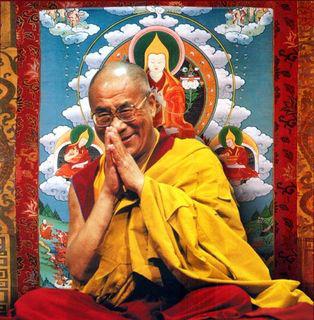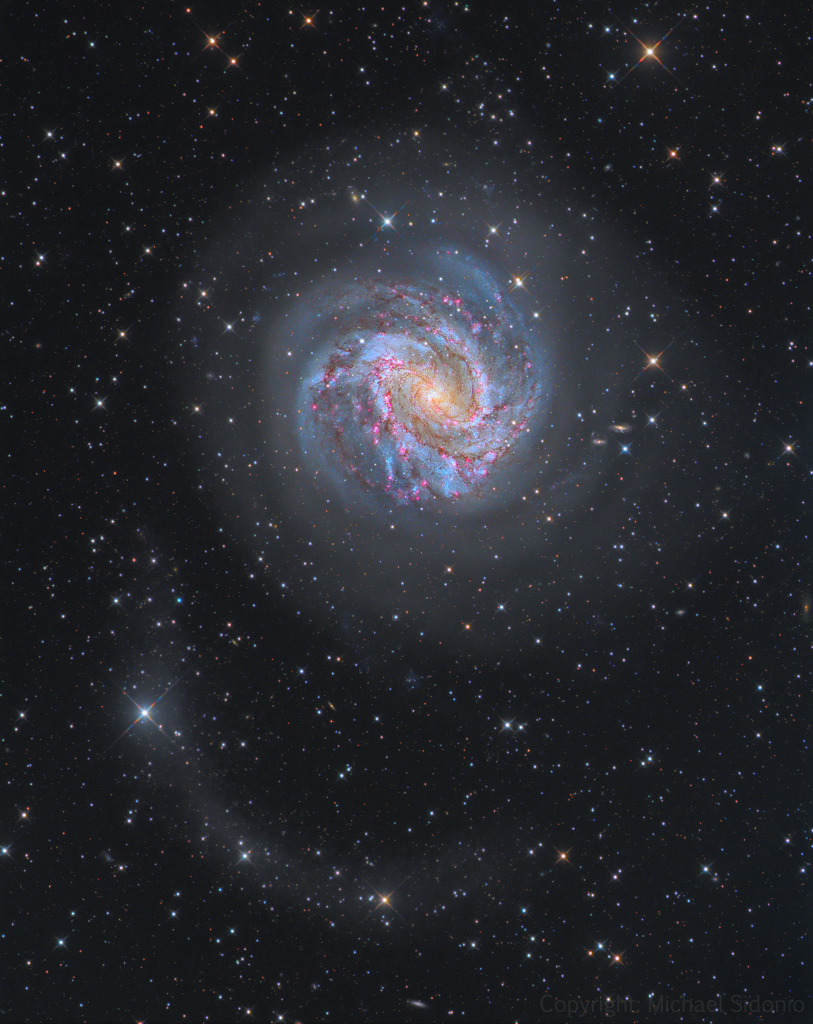Blog
“Time is always moving on; nothing can stop it. We can’t change the past, but we can shape the future. The more compassionate you are, the more you will find inner peace. From my own limited experience I have found that the greatest degree of inner tranquility comes from the development of love and compassion.” Dali Lama

Spiral galaxy M83 lies a mere twelve million light-years away, near the southeastern tip of the very long constellation Hydra. About 40,000 light-years across, M83 is known as the Southern Pinwheel for its pronounced spiral arms. But the wealth of reddish star forming regions found near the edges of the arms’ thick dust lanes, also suggest another popular moniker for M83, the Thousand-Ruby Galaxy. This new deep telescopic digital image also records the bright galaxy’s faint, extended halo. Arcing toward the bottom of the cosmic frame lies a stellar tidal stream, debris drawn from massive M83 by the gravitational disruption of a smaller, merging satellite galaxy. Astronomers David Malin and Brian Hadley found the elusive star stream in the mid 1990s by enhancing photographic plates.

Michael Shrieve (born July 6, 1949 San Fransisco) is an American drummer, percussionist, and composer. He is best known as the drummer of the rock band Santana, playing on the band’s first seven albums from 1969 to 1974. At age 20, Shrieve was the second youngest musician to perform at Woodstock. His drum solo during “Soul Sacrifice” in the Woodstock film has been described as “electrifying”, although he considers his solo during the same piece in 1970 at Tanglewood the superior performance.
more...Louie Bellson (born Luigi Paolino Alfredo Francesco Antonio Balassoni, July 6, 1924 – February 14, 2009 Rock Falls, Ill), often seen in sources as Louis Bellson, although he himself preferred the spelling Louie, was an American jazz drummer. He was a composer, arranger, bandleader, and jazz educator, and is credited with pioneering the use of two bass drums.
Bellson and his wife, actress and singer Pearl Bailey (married from 1952 until Bailey’s death in 1990), had the second highest number of appearances at the White House(only Bob Hope had more).
Bellson was a vice president at Remo, a drum company. He was inducted into the Modern Drummer Hall of Fame in 1985.
more...
Friday July 5th 6pm Erev Shabbat Service with Inbal Sharett-Singer, Jayson Rodovsky, Jeff Bailey, Pete Whitman and mick laBriola.
more...This Picture of the Week from the NASA/ESA Hubble Space Telescope depicts the galaxy NGC 4951, a spiral galaxythat’s located 49 million light-years from Earth in the constellation Virgo.
The data used to make this image were captured by Hubble as part of a programme to examine how matter and energy travel in nearby galaxies. Galaxies continuously undergo a cycle of star formation whereby the gas in a galaxy forms molecular clouds, which collapse to create new stars, which then disperse the clouds they formed from with powerful radiation or stellar winds in a process called feedback. The remaining gas is left to form new clouds elsewhere. This cycle of moving matter and energy determines how fast a galaxy forms stars and how quickly it burns through its supplies of gas — that is, how it evolves over the course of its life. Understanding this evolution depends on the nebulae, stars and star clusters in the galaxy: when they formed and their past behaviour. Hubble has always excelled at measuring populations of stars, and the task of tracking gas and star formation in galaxies including NGC 4951 is no exception.
NGC 4951 is also a Seyfert galaxy, a type of galaxy that has a very bright and energetic nucleus called an active galactic nucleus. This image demonstrates well how energetic the galaxy is, and some of the dynamic galactic activity which transports matter and energy throughout it: a shining core surrounded by swirling arms, glowing pink star-forming regions, and thick dust.
[Image Description: A spiral galaxy, tilted diagonally. It has thick, cloudy spiral arms wrapping around the core. They are filled with pink patches marking new star formation, young blue stars, and dark wisps of dust that block light. The galaxy glows brightly from its core. It is on a dark background, with a few distant galaxies and unrelated stars around it.]

Jaime Royal “Robbie” Robertson OC (July 5, 1943 – August 9, 2023) was a Canadian musician. He was lead guitarist for Bob Dylan in the mid-late 1960s and early-mid 1970s, guitarist and songwriter with The Band from their inception until 1978, and a solo artist.
Robertson’s work with the Band was instrumental in creating the Americana musicgenre. He was inducted into the Rock and Roll Hall of Fame and the Canadian Music Hall of Fame as a member of the Band, and into Canada’s Walk of Fame, with the Band and on his own. He is ranked 59th in Rolling Stone magazine’s list of the 100 greatest guitarists. He wrote “The Weight“, “The Night They Drove Old Dixie Down“, and “Up on Cripple Creek” with the Band and had solo hits with “Broken Arrow” and “Somewhere Down the Crazy River“, and many others. He was inducted into the Canadian Songwriters Hall of Fame, and received a Lifetime Achievement Award from the National Academy of Songwriters.
Robertson collaborated on film and TV soundtracks, usually with director Martin Scorsese, beginning in the rockumentary film The Last Waltz (1978) and continuing through dramatic films including Raging Bull (1980), The King of Comedy (1983), Casino (1995), Gangs of New York (2002), The Wolf of Wall Street (2013), Silence(2016), The Irishman (2019), and Killers of the Flower Moon (2023), scoring the latter shortly before his death. The film was dedicated to his memory, and garnered him a posthumous nomination for Best Original Score at the Academy Awards.
more...Arthur Murray Blythe (July 5, 1940 – March 27, 2017) was an American jazz alto saxophonist and composer. He was described by critic Chris Kelsey as displaying “one of the most easily recognizable alto sax sounds in jazz, big and round, with a fast, wide vibrato and an aggressive, precise manner of phrasing” and furthermore as straddling the avant garde and traditionalist jazz, often with bands featuring unusual instrumentation.
Born in Los Angeles, Blythe lived in San Diego, returning to Los Angeles when he was 19 years old. He took up the alto saxophone at the age of nine, playing R&B until his mid-teens when he discovered jazz. In the mid-1960s, Blythe was part of the Underground Musicians and Artists Association (UGMAA), founded by Horace Tapscott, on whose 1969 The Giant Is Awakened he made his recording debut.
more...Overton Amos Lemons (July 5, 1913 – October 7, 1966), known as Smiley Lewis, was an American New Orleans rhythm and blues singer and guitarist. The music journalist Tony Russell wrote that “Lewis was the unluckiest man in New Orleans. He hit on a formula for slow-rocking, small-band numbers like ‘The Bells Are Ringing’ and ‘I Hear You Knocking‘ only to have Fats Domino come up behind him with similar music with a more ingratiating delivery. Lewis was practically drowned in Domino’s backwash.”
more...The beautiful Trifid Nebula is a cosmicstudy in contrasts. Also known as M20, it lies about 5,000 light-years away toward the nebula richconstellation Sagittarius. A star forming region in the plane of our galaxy, the Trifid does illustrate three different types of astronomical nebulae; red emission nebulae dominated by light from hydrogen atoms, blue reflection nebulae produced by dust reflecting starlight, and dark nebulae where dense dust clouds appear in silhouette. But the red emission region, roughly separated into three parts by obscuring dust lanes, is what lends the Trifid its popular name. Pillars and jets sculpted by newborn stars, above and right of the emission nebula’s center, appear in famous Hubble Space Telescope close-up images of the region. The Trifid Nebula is about 40 light-years across. Too faint to be seen by the unaided eye, it almost covers the area of a full moon on planet Earth’s sky. 
William Harrison Withers Jr. (July 4, 1938 – March 30, 2020 Slab Fork, WV) was an American singer and songwriter. He had several hits over a career spanning 18 years, including “Ain’t No Sunshine” (1971), “Grandma’s Hands” (1971), “Use Me” (1972), “Lean on Me” (1972), “Lovely Day” (1977) and “Just the Two of Us” (1980). Withers won three Grammy Awards and was nominated for six more.
more...Stephen Collins Foster (July 4, 1826 – January 13, 1864), known as “the father of American music”, was an American composer known primarily for his parlour and minstrelmusic during the Romantic period. He wrote more than 200 songs, including “Oh! Susanna“, “Hard Times Come Again No More“, “Camptown Races“, “Old Folks at Home” (“Swanee River”), “My Old Kentucky Home“, “Jeanie with the Light Brown Hair“, “Old Black Joe“, and “Beautiful Dreamer“, and many of his compositions remain popular today.
more...Fred Wesley (born July 4, 1943 Columbus, GA) is an American trombonist who worked with James Brown in the 1960s and 1970s, and Parliament-Funkadelic in the second half of the 1970s.
more...More Posts
- Bill Doggett
- World Music EL KHAT & the Yemeni Orchestra
- Daily Roots The Key Allstars
- A Real President
- Echos of Freedom by Kahlil Gibran
- Kokomo Arnold
- Little Shop of Horrors
- Cosmo NGC 1097
- Ali Campbell
- Brian Holland
- Herlin Riley
- Nathan Davis
- World Music Tinariwen
- Daily Roots Junior Marvin
- Echos of Freedom by Rabindranath Tagore
- Happy Valentines Day 2025
- Little Shop of Horrors
- Cosmo NGC 2237
- Merl Saunders
- Tim Buckley

